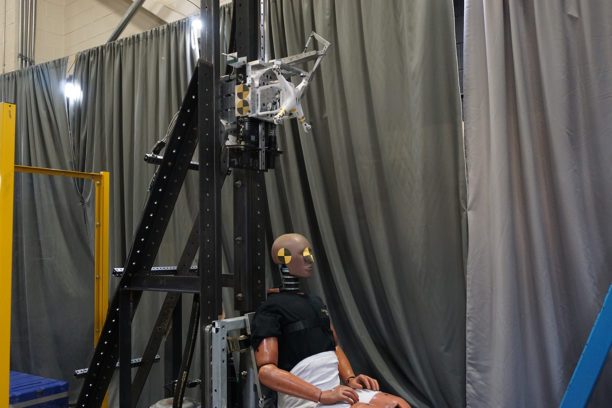
The study in question was published by the Alliance for System Safety of UAS through Research Excellence (ASSURE). The ASSURE research team “has developed a standard methodology by which potential injury may be evaluated.”
From an ASSURE press release:
Over 512 impact tests and simulations were conducted using 16 different multi-rotor and fixed-wing sUAS, as well as various objects and payloads (batteries, wood blocks, etc.) with weights ranging from 0.71 to 13.2 lbs. Testing also included evaluation of heavier sUAS using mitigations to reduce potential for injury, such as sUAS under parachutes.
“The injury impacts conducted in the study were controlled impact tests of the worst case, using those variables capable of transferring the most energy to a human,” said Arterburn. [David Arterburn, Director, Rotorcraft Systems Engineering and Simulation Center at The University of Alabama in Huntsville and principal investigator for the study.] “Even in these controlled studies, slight variations of the vehicle orientation or location of impact with the human, just prior to impact, reduced the injury potential. These results showed that these worst-case impacts are very difficult to achieve, even under controlled impact test conditions.” [Emphasis DRONELIFE.]
“The research results give the FAA a better picture of potential injuries and their severity, based on established science,” said Stephen P. Luxion, Col (Ret.), Executive Director, ASSURE. “Earlier testing of injury data strongly supported our assessment that long-standing fatality data was overly conservative and largely not applicable to injuries resulting from impacts by more elastic sUAS. [Emphasis DRONELIFE.] Additional testing was needed to develop a more accurate, science-based test methodology that may be used by the FAA, sUAS manufacturers, and operators of sUAS to evaluate the injury risk potential.”
“This data and the continued work that the ASSURE program is conducting may help inform future safety decisions for UAS integration in our National Airspace System,” continued Luxion.
Any pilot who has had to do a hand-catch without a glove, or who has accidentally gotten beneath his drone when landing ungracefully, understands that some pretty nasty cuts can result. But pretty nasty cuts are not the same thing as fatalities – and it’s a very significant difference when establishing regulations for flight over people. The ASSURE study provides some respected science to back industry claims that small quadcopters don’t pose extreme risk to people below.
ASSURE’s UAS focus is on research, education, and training critical to safe, efficient, and successful integration of UAS into the nation’s airspace. ASSURE has conducted initial research in: detect and avoid technology; low-altitude operations safety; control and communications; spectrum management; human factors; maintenance standards and requirements; compatibility with air traffic control. ASSURE membership is made up of 15 core universities, 8 affiliate universities, and over 110 industry partners. ASSURE membership includes representation in 13 states, 9 countries, and over 200 locations, and is core to 3 UAS Test Sites. Learn more at ASSUREuas.org.
Miriam McNabb is the Editor-in-Chief of DRONELIFE and CEO of JobForDrones, a professional drone services marketplace, and a fascinated observer of the emerging drone industry and the regulatory environment for drones. Miriam has penned over 3,000 articles focused on the commercial drone space and is an international speaker and recognized figure in the industry. Miriam has a degree from the University of Chicago and over 20 years of experience in high tech sales and marketing for new technologies.
For drone industry consulting or writing, Email Miriam.
TWITTER:@spaldingbarker
Subscribe to DroneLife here.
